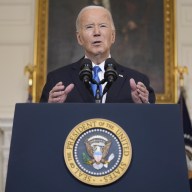 A new report from Comptroller Scott Stringer examines the numbers behind the need for affordable housing and what lawmakers can do to address the issue.
A new report from Comptroller Scott Stringer examines the numbers behind the need for affordable housing and what lawmakers can do to address the issue.
Credit: Don Emmert/AFP/Getty Images
A new report released Wednesday shows working class New Yorkers have particularly squeezed between sluggish incomes and rent hikes over the last 14 years.
The average American may have seen a rent hike of 44 percent since 2000, but New Yorkers on average are paying 75 percent more for rent than they did a little over a decade ago.
Meanwhile, New York City residents also saw their median income drop by 4.8 percent after adjusted for inflation.
The 40-page report from Comptroller Scott Stringer examined the numbers behind the city’s housing affordability woes, while offering some priorities for lawmakers tasked with alleviating homeowners and renters’ woes.
“It is critical to understand our City’s housing landscape so that we can target the next investment of resources,” Stringer said in a statement. “New York City’s position among global cities will be defined by how well we respond to this crisis.”
In the report, the comptroller commends Mayor Bill de Blasio’s commitment to create 200,000 affordable housing units within the next 10 years. The report emphasized the need for government subsidies to meet the city’s housing needs, dismissing the idea that the private market could create it at a faster rate as implausible.
When looking at the forces behind the increasing need for affordable housing, the report said that the oft-blamed gentrification process has had an affect on the city’s housing stock, albeit maybe less than people think.
“While gentrification of the city’s household distribution was an unlikely cause of rent inflation citywide during the Bloomberg era,” the report read, “the evidence at the borough and neighborhood level is more convincing.”
Using Brooklyn’s boom during the last 12 years as an example, the borough gained about 28,000 mid- and high-income households, compared to Manhattan’s 21,500. Meanwhile, the number of New Yorkers making $100,000 or more actually declined in every other borough.
“It may not be coincidental that Brooklyn experienced the largest increase in average rents while Queens and Staten Island the lowest,” the report added.
As to actually addressing the affordability issue, the report suggests that the city begin to focus on the housing needs of working families making less than $40,000 a year, who are particularly subject to stalled income and a dwindling supply of affordable rentals.
Stringer also proposes that lawmakers invest in the city’s Housing Authority, not only with stabilizing and preserving it but also rehabilitating existing units, which house almost 5 percent of the city’s entire population.
The comptroller’s office also addresses the city’s high homelessness rate and a fast-shrinking supply of rent-regulated housing, as well as the increasing issue of housing needs for the city’s elderly and disabled.
“In the modern era, there has been a crisis of affordability, but the conditions and the demands of that crisis have changed,” Stringer added. “We have begun to define the issues, now begins the work to provide affordable housing at all levels of the economic spectrum.”
Follow Chester Jesus Soria on Twitter@chestersoria
















